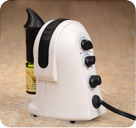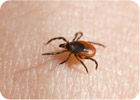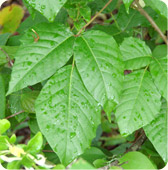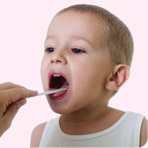
Essential Oil Guidelines for Babies and Children

General Guidelines
Quality: The quality of the essential oils matters. Choose premium-quality oils for all applications.
Dilute: Essential oils are typically used very diluted for babies and young children, and we avoid using oils on a newborn unless need outweighs potential risk. If there is a need to use essential oils on an newborn to 3 months, we will use 1-2 drops of essential oil to an ounce of a suitable carrier such as coconut, olive, avocado or almond oil. For general dilution guidelines, see the dilution chart on the Oil Usage page.
Test: Always test your application on yourself first and then on a very small area on your baby to be sure their skin will tolerate it.
Ouch!: If the dilution rate is not adequate, the baby's skin may redden and become hot. Dilute this effect by adding more carrier oil. Water may not dilute or reduce the effect but rather may intensify it.
Chronic Illness: For chronic issues, when you'll be applying the oils for a length of time, consider using more dilution and rotating through application sites. Essential oils are generally metabolized and eliminated in 1-2 hours, so reapplication for acute needs may be beneficial every couple hours.
Infection: Apply appropriately diluted oil to the spine, torso or bottoms of the baby's feet, then cover with clothing and socks.
Respiratory: Apply diluted oil to the baby's inner thighs, chest and/or back.
Diffusing
- Diffusing the oils in a baby's room is an effective way for the baby to inhale the beneficial molecules, providing anti-septic, anti-inflammatory, anti-viral, anti-bacterial and anti-fungal properties.
- There is no need to blast the room. Run the diffuser so that when you walk in, the essence of the aroma is noticeable, but not overpowering.
- When using on a daily basis, we suggest a very low level of diffusion so that the aroma of the essential oil is faintly noticeable, which in a bedroom would only diffuse a few drops daily.
-
There are times when we want to diffuse to prevent an illness. Intermittent diffusion is suggested where the diffuser cycles on for a time, such as 30 minutes on and 30 minutes off. In our family, we diffuse 5 minutes on and 20 minutes off. Intermittent diffusion is effective and safe for children.
-
Daily diffusion over many weeks or months may not be in the best interest of most children, as we feel it's important for their immune systems to be challenged so that it learns to fight.
Quick-glance, printable chart: General Guidelines for Essential Oil Usage on Babies and Young Children
Important Notes:
+ Use diluted essential oils unless otherwise noted.
+ Blends marked with (*) indicate blends by Hopewell Essential Oils.
+ Some topics below are linked to more general information which includes testimonies. Click on the health issue topic (for example the word "bronchitis"), or click on the Education tab at the top of the website, then on Health Care Topics to view additional information. Keep in mind that testimonies on other pages will may not reflect use with a child.
Dilution: The skin and organs of a newborn are very tender, so use these potent essential oils with the greatest dilution possible to achieve the desired results. With this as the basis of usage, consider the need and follow what you feel as the Lord leads. Always test your application on yourself first and then on a very small area on your baby to be sure their skin will tolerate it.
| AGE | Percentage | Max # Drops |
| infant - 3 months | 0.1% - 0.2% | 1 - 2 drops/ounce |
| 3 - 24 months | 0.25% - 0.5% | 2 - 5 drops/ounce |
| 2 - 6 years | 1% - 2% | 9 - 24 drops/ounce |
| 6 - 14 years | 1.5% - 3+% | 12 - 28 drops/ounce |
Thyme ct. linalool: Be sure to use the mild chemotype (ct.) linalool, which is excellent for use on children.
Lavender: Be sure to only use a premium quality Lavendula angustifolia, not Lavandin (Lavandin x hybrida).
Worwood Blends: Valerie Worwood is a well-known aromatherapist and author. Some of her beneficial formulas are listed below, but please don't feel restricted by these. Use them as guides. If you only have two of the oils she uses, then adjust the formula to accommodate what you have on hand. Some of the information and formulas are taken from Aromatherapy for the Healthy Child by Valerie Ann Worwood, 2000.
Eucalyptus and Peppermint are two of the most effective essential oils for respiratory issues including, but not limited to, congestion and infection. Eucalyptus is naturally high in a component called 1,8-cineole and Peppermint is naturally high in menthol. These components, when used inappropriately, can slow breathing and cause neurological distress, so it's important to use these oils at safe, yet effective, levels. Robert Tisserand, coauthor of Essential Oil Safety, warns that we should not apply essential oils with 40% or more 1,8-cineole and menthol content on or near the faces of young children. Dripping drops of any essential oil into the nostrils of a baby, child (or anyone for that matter) is clearly not sensible. Doing so has caused non-fatal yet serious toxicity and may interfere with the respiratory system. This should not then be taken to mean that any preparation containing 1,8-cineole or menthol is dangerous to children per se. Long-time aromatherapy experts used Eucalyptus successfully with their children because they used traditional, safe application and dilution practices, which effectively lower the 1,8-cineole and/or menthol content below the risk level. Robert Tisserand also wrote: "1,8 cineole rich oils and Eucalyptus are safe to diffuse for children if we are talking about two or three drops in a diffuser for a moderately small bedroom." Diffusing at a level where the aroma of the oil is only faintly noticeable is safe for any length of time (using a few drops per 24 hours). We use a higher level of diffusing (intermittently such as 5 minutes on and 20 minutes off) as needed to address an illness.

Bronchitis
Niaouli, Rosalina, Myrtle, Thyme ct. linalool,
Breathe Easy*
Bronchitis Blend (by Valerie Worwood):
1 drop Niaouli
1 drop Eu. radiata+ (High in 1,8-cineole; Rosalina is a suitable alternative)
1 drop Thyme ct. linalool
2 drops Myrtle
Dilute appropriately for age/need and apply to inner thighs, back and chest over the lung area. Applying to inner thighs will quickly reach the heart/lung circulatory system.(See Dilution Chart at the top of this page under Important Notes.)
Diffuse: Choose one or a combination of the essential oils above to diffuse.
+Although Worwood uses essential oils that have recently (Tisserand 2014) been removed from children's formulas, when diluted and applied per her instructions, they fall well with-in safe ranges.
Bruises
Lavender, Geranium, Helichrysum, Ouch!*
Dilute appropriately for age/need. (See Dilution Chart at the top of this page under Important Notes.)
Gently apply to bruised tissue.
Burns (superficial from heat)
Lavender, German Chamomile, Helichrysum, Skin Restore Spray*
Lavender - Be sure to only use a premium-quality Lavendula angustifolia. Immediately cool the skin with cold water (not ice) for about 10 minutes and then apply diluted Lavender. Diluting Lavender with aloe vera is soothing and cooling. (See Dilution Chart at the top of this page under Important Notes.)
Keep burns moist to help them to heal more quickly. Skin Restore Spray* allows you to keep the burn moist without disturbing it by touching when applying.
Chicken Pox
Lavender, German Chamomile, Roman Chamomile, Tea Tree, Skin Restore Spray*
Baking Soda Bath: Add a few drops of essential oils to 1-cup baking soda and then to bath water.
Oatmeal Bath: Put a handful of raw oatmeal into a cloth and close securely. Drop about 8-10 drops essential oils onto the material, and let the water run over the ball as it fills the tub.
Chicken Pox 1% Spray: Dilute with additional Aloe Vera for very small babies.
¼ cup distilled Witch Hazel
¼ cup Aloe Vera - check the ingredients on the label
20 drops Lavender essential oil
7 drops Lemon essential oil
7 drops Bergamot essential oil
3 drops Peppermint essential oil
Use a glass spray bottle and shake well before each use. Test on a small area first to be certain it will be a blessing and not at all irritating. Avoid eyes and mucus membranes.
Colds and Runny Nose
Tea Tree, Thyme ct. linalool, Rosalina, Manuka, Lavender, Breathe Easy*
Apply a diluted combination of essential oils or a single oil to back, throat, chest, inner thighs.
(See Dilution Chart at the top of this page under Important Notes.)
Diffuse: Choose one or a combination of the essential oils above to diffuse.
Cold Sores / Fever Blisters
Manuka, Tea Tree, Lavender, Melissa, Geranium, Thyme ct. linalool, German Chamomile
Use a fresh cotton swab each time you apply. All the above except Melissa and Thyme ct. linalool can usually be applied as described with a cotton swab with less dilution on a child over age two, but to avoid skin irritation, consider diluting per the Dilution Chart at the top of this page under Important Notes.
Colic
Cardamom, Ginger, Tummy Soothe*
Apply diluted to abdomen. (See Dilution Chart at the top of this page under Important Notes.)
Something to consider about the possible nature of gas pain: the specific terminology of what is going on internally may not be correct, but moms who have tried this have all reported improvement.
Consider this scenario:
1. Mom nurses baby at 9 o'clock.
2. Baby begins to fuss at about 11 o'clock, so mom thinks she should nurse again, thinking, "He must be hungry." But the reality is that the 9 o'clock feeding is just about digested, and her baby needs to wait another hour until his tummy is empty.
3. Mom nurses baby at 11 o'clock so this puts fresh milk in with almost digested milk. The almost digested milk must now hang around in the tummy until the 11 o'clock nursing is digested, and it begins to sour.
4. The soured milk causes gas, and baby cries because he's so uncomfortable. Mommy thinks baby must be hungry and nurses again.
5. This adds more fresh milk to almost digested milk and soured milk. The soured milk causes all the milk to go "bad" and creates more gas and more crying, and mommy thinks he's hungry and needs to nurse again.
6. This cycle goes on and on until mommy realizes that she must make her miserable baby wait at least 3 hours between feedings, and then baby is relieved and the colic disappears.
Constipation
Ginger, Spearmint, Roman Chamomile, Tummy Soothe*
Gently massage diluted essential oils over the abdomen as needed. (See Dilution Chart at the top of this page under Important Notes.)
Coughs
Lemon, Fir Needle, Niaouli, Pine (for a wet cough), Rosalina, Thyme ct. linalool, German Chamomile, Breathe Easy*
Cough Mix (by Valerie Worwood)
10 drops Ravintsara+ (high in 1,8-cineole)
10 drops Eucalyptus radiata+ (high in 1,8-cineole)
5 drops Niaouli
Dilute per age/need. (See Dilution Chart at the top of this page under Important Notes.)
Use a small amount each time. Apply to chest, back and inner thighs. Never use these oils on the face of a baby or small child.
+Although Worwood uses essential oils that have recently (Tisserand 2014) been removed from children's formulas, when diluted and applied per her instructions, they fall well with-in safe ranges.
Cradle Cap
Lavender, Cedarwood, Geranium, Sandalwood, Tea Tree, Orange, Lemon
Cradle Cap Blend (by Valerie Worwood)
In a 1-oz glass bottle, mix:
½ oz Avocado oil or suitable carrier oil
½ oz Jojoba oil or suitable carrier oil
1 drop Tea Tree
1 drop Orange
1 drop Lemon
Use a small amount each time and gently smooth over the scalp to help loosen scales. Leave on for a few minutes or overnight and then shampoo off with a mild, natural shampoo. (Avoid shampoos and products with ingredients you can't pronounce.) Be careful to avoid the baby's eyes and face.
Croup
Niaouli, Ravintsara, Thyme ct. linalool, Palmarosa, Eucalyptus radiata+ (Rosalina is a suitable alternative), Myrtle, Breathe Easy*
Croup Blend (by Valerie Worwood)
15 drops Niaouli
15 drops Ravintsara+ (High in 1,8-cineole; Rosalina is a suitable alternative)
10 drops Thyme ct. linalool
10 drops Palmarosa
Dilute per age/need. (See Dilution Chart at the top of this page under Important Notes.)
Using a small amount, massage chest and back. Never use these oils on the face of a baby or small child.
+Although Worwood uses essential oils that have recently (Tisserand 2014) been removed from children's formulas, when diluted and applied per her instructions, they fall well with-in safe ranges.
Cuts and Scrapes
Helichrysum, Lavender, Manuka, Myrrh, Patchouli, Tea Tree,
Helichrysum is known to stop excessive bleeding.
Add 5 drops each of Lavender and Tea Tree to warm water to wash the wound.
Add 1 drop each of Lavender and Tea Tree to aloe vera and apply to a band-aid or gauze.
Wound Cleanse (adapted from The Complete Aromatherapy & Essential Oils Handbook for Everyday Wellness by Perchon/Cantele, page153)
1/2 tsp manuka honey or unpasturized honey
8 drops Manuka or Tea Tree (or a combination of the two)
5 drops Lavender
3 drops Helichrysum
1/4 cup filtered or distilled water or Lavender, Tea Tree or Helichrysum hydrosol
Combine the honey with the essential oil first until thoroughly incorporated. Pour into a 2oz glass bottle and add the water or hydrosol. Shake well before using. Apply with a cotton ball to clean the wound. If practical, leave the wound uncovered. Refrigerate to prolong shelf life.
Healing Blend
10 drops Helichrysum
8 drops Manuka or Tea Tree
6 drops Lavender
5 drops Myrrh
4 drops Patchouli
Dilute per age/need. (See Dilution Chart at the top of this page under Important Notes.)
Diaper Rash
Lavender, Tea Tree (esp. for Candida/yeast), Roman Chamomile, German Chamomile, Geranium, Manuka, Palmarosa, Rosalina, Yarrow, Thyme ct. linalool, Diaper Rash Cream,* Tender Skin Spray,* Tender Skin Salve*
Diaper Rash Blend (by Valerie Worwood)
3 oz Jojoba oil
1 oz Olive oil
Worwood suggests that you heat these oils and then let them return to room temperature. Once cool, add:
8 drops German Chamomile
4 drops Lavender
4 drops Ravintsara+ (High in 1,8-cineole; Rosalina is a suitable alternative)
8 drops Tea Tree, especially if you suspect it is caused by yeast/candida (Manuka is a good alternative)
Apply a small amount at each diaper change until the rash heals completely. Try to avoid the penis, testicles or vulva area. Do not use undiluted essential oils on cuts or cracks in the skin. Comfrey/Calendula Salve* would be a better choice for raw areas or cracks in the skin.
+Although Worwood uses essential oils that have recently (Tisserand 2014) been removed from children's formulas, when diluted and applied per her instructions, they fall well with-in safe ranges.
Diaper Lotion (adapted from The Complete Aromatherapy & Essential Oils Handbook for Everyday Wellness by Perchon/Cantele, page167)
4 tsp Calendula infused oil
4 tsp Sweet Almond oil
5 drops Lavender
3 drops Roman Chamomile
2 drops Frankincense
2 drops Geranium
1/4 cup + 4 tsp Hopewell's Baby Cream or Unscented Lotion
In a 4oz glass or PET plastic bottle, combine the carrier oils with the essential oils. Then add lotion and shake vigorously to thoroughly combine.
Candida: Active yogurt (non-flavored) can be applied with essential oils added, 15 drops essential oil to 1-ounce plain, unflavored yogurt.
Diarrhea
Lavender, Basil ct linalool, Cypress, Geranium, Roman Chamomile, Sandalwood, Thyme ct. linalool, Tea Tree, Tummy Soothe*
Dilute appropriately for age/need and apply to the abdomen. (See Dilution Chart at the top of this page under Important Notes.)
Earaches and Infections
Lavender, Ledum, Roman Chamomile, Juniperberry, Thyme ct. linalool, Marjoram, Tea Tree, Helichrysum, Gentle Joy Blend*
Never put undiluted essential oils into the ear canal
For children over 2 years of age, a 2% dilution of suitable oils may be appropriate if you are certain that the eardrum is not perforated. If the child has tubes, you will want to consult your MD before use as well.
Dilute per age/need. (See Dilution Chart at the top of this page under Important Notes.)
Gently massage around the back of the affected ear, outside the ear, on the side of the head and down the throat (as encouraging the ear to drain).
Put a drop or two of appropriately diluted essential oil on a cotton ball and gently place in ear opening. Replace 3-4 times daily as needed. Do not use this method if your child might pull the cotton ball out and choke on it.
Eczema
Lavender, German Chamomile, Roman Chamomile, Palmarosa, Patchouli, Bergamot, Elemi, Yarrow, DermaSoothe Spray*
Eczema Blend 1% dilution (by Valerie Worwood)
Mix these essential oils together:
10 drops Lavender
10 drops Roman Chamomile
6 drops Palmarosa
2 drops Bergamot
Mix the following carrier oils together:
2 oz Almond oil
1 oz Jojoba oil
6 drops Evening Primrose
(Other carrier oils noted for eczema: Avocado, Calendula Infused oil, Carrot Seed, Emu, Tamanu, Sesame)
In a 4-oz glass bottle, combine the essential oil mix with the carrier oils.
Initially apply a small amount to a very small affected area to see how the skin responds. If any irritation occurs, dilute with more carrier oil or discontinue use.
Bedwetting (Enuresis)
Cypress
Dilute per age/need and gently massage onto the child over the bladder before bedtime. (See Dilution Chart at the top of this page under Important Notes.)
Sometimes bedwetting indicates that the brain does not know where the body is in time and space. Here's a tried and true method that countless families have used to eliminate bedwetting in their children (offered by Julie Meekins with March Forth Family):
Arm and Leg Squeezes: You want their brain to wake up to feel things more appropriately. How do you do that? It is about getting specific stimulation to the brain. Note that I said "specific" not random. There is a great deal of random stimulation (overkill) in our world today; all that does is confuse things.
Our recommendation is this: Every day for about five minutes at a time, several times a day, give your child arm and leg squeezes. Deeply massage all four limbs several times a day, and it will give signals to the brain that will enable the child to know where his or her body is in time and space. We did this activity with our children. Our hyperactive child began to settle down and now is no longer hyperactive. Squeeze just below the pain threshold. You don't want it to hurt, but you want them to feel it. Every child is different in how they feel it. So you will have to experiment with your child. Most children LOVE this activity. Some children have to get used to it at first, but then they begin to request their squeezy time and look forward to it.
Epilepsy (Seizures)
Jasmine Absolute, Neroli, Rose, Petitgrain Bigarade, Roman Chamomile, Geranium
Dilute 5 drops essential oil with 1-oz carrier oil (0.5% dilution).
Use a small amount and massage the child's back at bedtime. Use upward strokes toward the neck. Do this twice a week and reduce gradually if the child improves. If what you are using seems to have a positive effect in reducing the incidence of seizures, apply to a handkerchief so the child can inhale it as desired.
(The following oils are generally NOT recommended for use by those with seizure tendencies:
Anise, Birch, Camphor, Fennel, Hyssop, Lavandin, Nutmeg, Parsley, Pennyroyal, Peppermint, Rosemary, Sage, Spike Lavender, Thuja, Wormwood, Yarrow.)
Kurt Schnaubelt PhD writes that "the much-feared potential of Rosemary oil to induce seizures has so far failed to throw all of Britain into a collective state of epilepsy," thereby expressing his feeling that many of the warnings about Rosemary lack validity.
Fever
Ginger, Lavender, Lemon, Tea Tree, Roman Chamomile, Spearmint
Reasonable fever is our friend helping to fight infection, but if you feel you must reduce it, add a few drops of essential oils to a bowl of water, dip a flannel compress, squeeze out and place on the child's back for about 5 minutes. Make sure the water is not too cold but pleasantly comfortable to the child. Gently dry the skin and gently massage appropriately diluted essential oils on the back. (Peppermint is not typically used on children under 5 due to high menthol content. When appropriately diluted and not applied on or near the face, risk is diminished.) Apply infection-fighting oils to spine. (See Dilution Chart at the top of this page under Important Notes.)
Testimony
I used these oils on my son for febrile seizures. It was the only thing that helped him. - Doriann
Flu
Copaiba, Frankincense, Lavender, Wild/Sweet Orange, Palmarosa, Pine, Thyme ct. linalool, Tusga Spruce, Immune Support*
Flu Body Massage 2% dilution (Consider the age/need and adjust dilution per Dilution Chart at the top of this page under Important Notes.)
½ oz Almond oil (or a suitable carrier)
5 drops Thyme ct. linalool
5 drops Rosalina
Use 1-teaspoon to massage the arms and legs as well as the neck, back and front. Avoid genital area.
Diffuse: Choose one or a combination of the essential oils above to diffuse.
Hand, Foot and Mouth Disease
Thyme ct. linalool, Geranium, Tea Tree, Lavender, Helichrysum, Cypress, German Chamomile, Frankincense
Mouth Blister Blend (adapted from Valerie Worwood) - use only if the child knows how to spit it out
1oz Aloe Vera
1oz Water
1 tsp raw, unprocessed Honey (not suitable for a child under 12 months)
1 drop Cypress
1 drop Frankincense
Combine and shake well (the essential oils will float to the top).
Add 1-teaspoon to a 6-oz glass of water.
Have the child rinse their mouth and then spit it out. (Encourage them to avoid getting the water/essential oil on their lips.)
Repeat as often as desired.
Testimonies about using Frankincense for Hand, Foot and Mouth Disease
Hives
Roman Chamomile, German Chamomile, Lavender, Helichrysum
Apply a small amount of the following anti-inflammatory blend over affected area:
Hives Blend 2% dilution (By Valerie Worwood)
½ oz Almond oil
3 drops German Chamomile
4 drops Lavender
2 drops Helichrysum
Adjust dilution ratio per age/need. (See Dilution Chart at the top of this page under Important Notes.)
Impetigo
Tea Tree, Thyme ct. linalool, Manuka, Lavender, German Chamomile, Impetigo Blend*
Impetigo is a highly infectious skin infection caused by the bacteria staphylococcus aureus. Bacteria grow on nonliving hosts, such as doorknobs and countertops (as opposed to a virus that requires a living host, such as people). It usually starts as a red area, which can be painful and itchy. After a day or so, the infected area may become crusty with a characteristic golden color. If not treated, the infection becomes more widespread.
Impetigo easily spreads not only from person to person, but the infection can be spread from one area of skin to another on the same person. Wash hands thoroughly after treating the lesion and dispose of used dressings. Wash all clothing, sheets, towels, washcloths in hot water. Adding essential oils to the wash may help prevent spreading of the infection.
Treatment with essential oils is very effective because bacteria cannot form a resistance to an essential oil like it can to an antibiotic.
Impetigo Tea Dab* (by Valerie Worwood)
15 drops Ravintsara+ (High in 1,8-cineole; Rosalina is a suitable alternative)
15 drops Tea Tree
10 drops Thyme ct. linalool
10 drops Manuka or substitute Tea Tree
Add to 2-oz pure water. Dab over area of concern with a cotton cosmetic pad and repeat as necessary. Dispose of the pad and bandages to prevent spreading of the infection.
+Although Worwood uses essential oils that have recently (Tisserand 2014) been removed from children's formulas, when diluted and applied per her instructions, they fall well with-in safe ranges.
Insect Bites
Lavender, German Chamomile, Helichrysum, Cedarwood, Geranium, Thyme ct. linalool, Ouch!* or any HEO Gentle Blends*
These oils can be used undiluted on the bite depending on the age of the baby and number of bites, but we suggest diluting the oil so that you minimze risk of skin irritation/sensitization. Avoid areas where the child might rub it in the eyes.
Prevention: No Bites!*
Lice
Manuka, Tea Tree, Clove, Lavender, Thyme ct. linalool, Eucalyptus radiata (Rosalina is a suitable alternative)
Many commercial, chemical preparations should not be used by pregnant woman or infants under 3 years of age. For prevention for a baby, you may want to use 3 drops of the following mixture in baby shampoo and rinse thoroughly.
No Lice Formula
20 drops Tea Tree + 15 drops Lavender + 10 drops Eucalyptus radiata (Rosalina is a suitable alternative)
Add 10 drops of this blend to 1-TB Jojoba oil and apply it to the scalp.
Make sure you don't get this in the child's eyes or ears. If you do, add Jojoba or a carrier oil to dilute, not water.
Cover the hair and leave for 2+ hours or overnight.
Follow the combing and rinsing directions below.
Comb
Using a fine-toothed comb, gently comb, wiping the comb between each sweep through the hair. You may want to pass the comb through vinegar each time to help clean the comb. For long hair, you may need to use clips to separate the hair as you comb in sections. When you have combed the whole head, wash the hair over a sink or bathtub with shampoo. (If you do this in a shower, you may not be able to rinse the lice and eggs effectively off your body.) Then use the following rinse.
Rinse
2 ounces vinegar + 2 ounces water + 10 drops No Lice!* essential oil blend
- Shampoo the hair while leaning over a sink or bathtub (not in a shower - you want the lice and eggs to go down the drain, not onto your body).
- Shake the rinse blend very well and then pour the rinse through the hair, making sure it doesn't get into the eyes or ears. For long hair, this may be easier to apply using a peri or similar type bottle.
- Repeat this process a week later to remove any that have hatched out from eggs that remained.
~ The rinse is used after each treatment. The rinse by itself is ineffective. ~
Note: Jojoba oil is said to dissolve sebum, which may help the essential oils penetrate the insect cuticle faster. Other carrier oils could also be tried, as the insect cuticle is generally soluble to lipids and lipid-soluble compounds. Olive oil overnight on lice eggs prevented the majority of the eggs from developing, but it did not work as effectively with adult lice.
Lyme Prevention
Clothing Deterrent Combo (by Valerie Worwood)
30 drops Citronella
30 drops Lemongrass
20 drops Eucalyptus radiata (Rosalina is a suitable alternative)
10 drops Peppermint
10 drops Niaouli
Put 1-2 drops on socks, bottoms of pants, hems, shirt cuffs, collars and around brim of hats. The essential oils may leave a little residue stain on the material.
Lyme Prevention Body Oil -1% dilution ratio
1 TB carrier oil
2 drops Geranium
3 drops Palo Santo
Tick Removal: Do not aggravate the tick by putting anything on it's back, as it may regurgitate the dreaded bacteria into the host. Using the Tick Tool or tweezers, grab the tick closest to the skin at attachment and gently tug until it releases. Do not twist or jerk the tick.
Lymph Glands, Swollen
Thyme ct. linalool, Tea Tree, Manuka
Dilute appropriately and apply on the swollen lymph gland.
Measles/Rubeola
German Chamomile, Niaouli, Thyme ct. linalool, Eucalyptus radiata+ (High in 1,8-cineole; Rosalina is a suitable alternative), Bergamot, Lavender, Ravintsara+ (High in 1,8-cineole; Rosalina is a suitable alternative), Cajeput, Tea Tree
Measles is a highly contagious, airborne, viral infection that is spread through coughing and sneezing. After exposure, the incubation period is approximately 10-14 days. According to WHO (World Health Organization), the Measles virus uses a lot of vitamin A, so supplementing with 200,000 IU/day for a week helps. Some also give high doses of vitamin C.
Oat Bath
Put a handful of raw oats or oatmeal in a piece of cotton fabric and add:
4 drops German Chamomile
4 drops Lavender
4 drops Ravintsara+ (High in 1,8-cineole; Rosalina is a suitable alternative)
Secure the bundle and hold it under the faucet as the water fills the tub.
+Although Worwood uses essential oils that have recently (Tisserand 2014) been removed from children's formulas, when diluted and applied per her instructions, they fall well with-in safe ranges.
Meningitis
Roman Chamomile, German Chamomile, Lavender, Cardamom, Ravintsara+ (High in 1,8-cineole; Rosalina is a suitable alternative), Palmarosa, Niaouli, Immune Support*
Bacteria Top Gun* (if bacterial), Warrior* (if viral) - these are potent blends not typically used with small children. Please be responsible and weigh the risks and dilute appropriately if used.
This is a life-threatening disease; please consult with your heathcare professional. Use essential oils in foot/back massage, not all over the body. These essential oils may help lessen the symptoms and can be used alongside conventional treatment. A meningitis rash will stay visible if you press a clear glass against it, whereas most rashes will temporarily disappear.
+Although Worwood uses essential oils that have recently (Tisserand 2014) been removed from children's formulas, when diluted and applied per her instructions, they fall well with-in safe ranges.
Mumps
Tea Tree, Lemon, Roman Chamomile, Niaouli, Eucalyptus radiata+ (High in 1,8-cineole; Rosalina is a suitable alternative)), Coriander, Lavender, Ravensara Leaf, Helichrysum
Caused by an airborne virus that affects the parotid salivary glands.
Mumps Massage Blend (by Valerie Worwood)
Twice daily, use diluted to gently massage back. Apply to neck without massage.
15 drops Lavender
5 drops Roman Chamomile
5 drops German Chamomile
5 drops Eucalyptus radiata+ (High in 1,8-cineole; Rosalina is a suitable alternative)
Dilute per age/need. (See Dilution Chart at the top of this page under Important Notes.)
+Although Worwood uses essential oils that have recently (Tisserand 2014) been removed from children's formulas, when diluted and applied per her instructions, they fall well with-in safe ranges.
Nasal Congestion
Myrtle, appropriately diluted may be swabbed around the nostrils for babies and and children. Follow with an appropriate salve such as Golden Salve* or Comfrey/Calendula Salve* to keep the nostrils moist.
NeilMed Sinus Rinse Pediatric Kit:
First make up the salt mix. Each time you use the NeilMed, you'll make up a fresh batch.
Sea Salt Mix for a child over 10 years of age
8 TB very fine Sea Salt
10 drops Rosemary ct. verbonone
6 drops Tea Tree or Manuka or Myrtle
Mix well and store in a glass jar.
When needed, mix the following until the salt has dissolved and use in NeilMed to flush sinuses:
1 tsp of the Sea Salt Mix recipe
1 ½ cup warm (body temperature) distilled water
Pinworms
Fresh garlic has worked for many, although it is not suggested for a baby.
Mince or finely chop a garlic clove, mix it with something like a little mashed sweet potato or something to help it go right down. Have a cup of liquid handy so they can take a drink afterwards. Do this twice daily for a few months. It actually becomes a good habit so you may want to keep it up. It is recommended that everyone in the family do this, but this may not be practical. Keep the child in his own bed and wash the sheets in hot water and dry them in the sunshine. The garlic should take care of the visible manifestation of the worms crawling out the anus rather quickly - in a few days - at this point you may want to back off the rigid sheet washing and just maintain the garlic. The live worms should be dead, and we keep the garlic going to kill all the ones that are still to hatch out.
Life cycle:
- A person ingest or inhale pinworm eggs.
- They hatch in your intestines.
- They mate there as well, and the males die.
- About two to three months later the females crawl out and lay eggs, up to ten thousand per worm. (I can hardly believe someone counted!) Then the females die.
Worwood's Tummy Massage 3% dilution ratio (To adjust ratio, see Dilution Chart at the top of this page under Important Notes.)
Into one ounce sesame seed oil, mix the following:
3 drops Clove
6 drops Niaouli
10 drops Cardamom
8 drops Bay Laurel
Apply a small amount of the formula over the child's back and stomach area. Cover with a warm, dry compress until cool. Massage a small amount of plain sesame oil over the stomach only. Use for no longer than one week.
+Although Worwood uses essential oils that have recently (Tisserand 2014) been removed from children's formulas, when used diluted and applied per her instructions, they fall well with-in safe ranges.
Pneumonia
Ravintsara+ (High in 1,8-cineole; Rosalina is a suitable alternative), Niaouli, Elemi, Tea Tree, Thyme ct. linalool, Breathe Easy,* Immune Support*
Pneumonia Mix (by Valerie Worwood)
10 drops Ravintsara+ (High in 1,8-cineole; Rosalina is a suitable alternative)
10 drops Eucalyptus Citriodora
5 drops Niaouli
5 drops Thyme ct. linalool
Diffuse: This blend can be diffused (add 5 drops Cinnamon Bark for a serious situation).
Body Rub: Mix 10 drops Pneumonia Mix with 1 TB carrier oil - massage over back, chest and inner thighs.
Suppository: Pneumonia, chronic bronchitis and lung congestion respond very quickly to essential oils when delivered by suppositories. The essential oils bypass the liver and are fed directly into the heart-lung circulatory system. Thus, they reach the lower bronchial capillaries in their original lipophilic and volatile state, still capable of eliminating pathogenic microorganisms and dissolving and expectorating mucus. If helpful, a suppository can be used every 1-2 hours as needed. A quick way to use a suppository is to put 1-3 drops of Breathe Easy blend, Rosemary ct. verbenone, Myrtle or another mild oil of choice into an empty capsule and fill the rest full with a carrier oil such as Olive or Castor oil. Lubricate the capsule liberally and insert. Lie down or recline for about 30 minutes as the essential oils dissolve the capsule and move into the lungs. Always test your application on yourself before you apply to your child. Adjust the dilution if needed.
Suppository for a Baby:
Put 1 drop essential oil (choose a mild one such as Breathe Easy blend, Rosemary ct. verbenone or Myrtle) into a capsule and fill with a carrier oil (such as virgin Coconut oil or Olive oil). Lubricate well, and with the baby's knees bent to the chest, gently insert. Try to allow the baby/child to remain at rest about 30 minutes while it dissolves. If noticeably effective, repeat when/if the improvement wanes. Since essential oils are eliminated out of the body tissues in 1-2 hours, a suppository can be inserted every 1-2 hours as needed.
+Although Worwood uses essential oils that have recently (Tisserand 2014) been removed from children's formulas, when used diluted and applied per her instructions, they fall well with-in safe ranges.
Poison Ivy
Roman Chamomile, German Chamomile, Lavender, Itchy Rash Spray* (for older children)
Use a cool compress to help soothe the rash.
Suggested mix:
4 drops German Chamomile
4 drops Lavender
2 drops Helichrysum
Soak the compress in the water, squeeze out and apply to the rash.
Dilute per age/need with Aloe Vera and use from a glass or PET plastic spray bottle. (See Dilution Chart at the top of this page under Important Notes.)
Rash Cream 1% dilution ratio
2 oz Elizabeth's Natural Unscented Cream (or a natural cream of choice)
10 drops Lavender
3 drops Carrot Seed
2 drops Geranium
2 drops Chamomile
Psoriasis
Roman Chamomile, German Chamomile, Lavender, Spikenard, Bergamot, Rose, Derma Soothe Blend*
Psoriasis Skin Blend (by Valerie Worwood)
1 oz Calendula infused oil
4 drops Bergamot
3 drops Roman Chamomile
Apply to small patches of dry, flaky skin.
Rash Cream 1% dilution ratio
2 oz Elizabeth's Natural Unscented Cream (or a natural cream of choice)
10 drops Lavender
3 drops Carrot Seed
2 drops Geranium
2 drops Chamomile
Respiratory Congestion
Balsam Fir, Cypress, Eucalyptus radiata+ (High in 1,8-cineole; Rosalina is a suitable alternative), Myrtle, Palmarosa, Ravintsara+ (High in 1,8-cineole; Rosalina is a suitable alternative), Rosalina, Spearmint, Thyme ct. linalool, Black Spruce, Breathe Easy*
Dilute per age/need and gently massage chest, back and inner tighs several times daily. (See Dilution Chart at the top of this page under Important Notes.)
+Although Worwood uses essential oils that have recently (Tisserand 2014) been removed from children's formulas, when diluted and applied per her instructions, they fall well with-in safe ranges.
Ringworm
Lavender, Manuka, Tea Tree, Palmarosa, Neem, Geranium
Ringworm Mix (by Valerie Worwood)
Ringworm looks like a bull's-eye, circular or ring-shaped, with an unaffected area in the middle. The outer ring marks the active area of the fungus, and the center heals as the circle gets larger. It is contagious by touching or sharing belongings such as hats, clothes, brushes, combs, towels and so on. It can last up to 6 weeks. Cover to stop the spread.
8 drops Neem
5 drops Tea Tree
5 drops Manuka
Apply to the ringworm spot 3 times daily.
Ringworm Blend (by Purchon/Cantele in The Complete Aromatherapy and Essential Oils Handbook for Everyday Wellness)
16 drops Manuka
16 drops Palmarosa
16 drops Sandalwood or Cedarwood
16 drops Tea Tree
Combine in a 5 mL glass dropper bottle. Dilute per age/need. (See Dilution Chart at the top of this page under Important Notes.)
It is suitable to add drops of this blend into unscented lotion.
Using a cotton ball, apply to affected are several times daily for 3-4 weeks. Although the ringworm may appear to be healed, it can linger as a hidden infection for several weeks.
Rubella/German Measles
Lavender, Roman Chamomile, German Chamomile, Geranium, Thyme ct. linalool, Tea Tree, Bergamot, Immune Support*
This is the milder form of the measles and is not harmful unless caught by a pregnant woman during the first four months of pregnancy. This is an airborne viral infection that causes a rash that may start behind the ears and spread to cover most of the body. It lasts 3-15 days. Incubation time is generally 14-21 days, and the child is contagious while they have the rash and up to 7 days after it disappears.
Use a combination of oils such as Lavender, Chamomiles, Bergamot and Geranium in a bath or diluted as a body massage.
Dilute per age/need. (See Dilution Chart at the top of this page under Important Notes.)
Skin Spray (adapted from Perchon/Cantele in The Complete Aromatherapy and Essential Oils Handbook for Everyday Wellness)
2 oz spray bottle (glass or PET plastic)
8 drops Lavender
8 drops Chamomile
1/2 tsp unpasteurized liquid Honey
1/8 cup Witch Hazel
Shake well to combine. Fill the bottle to the shoulder with Lavender hydrosol, distilled or filtered water.
Shake well to combine and spray on the spots to ease itching.
Sinusitis
Myrtle, Tea Tree, Eucalyptus radiata+ (High in 1,8-cineole; Rosalina is a suitable alternative), Roman Chamomile
Appropriately diluted Myrtle can be swabbed around the nostrils. Follow with a gentle salve such as Golden Salve* or Comfrey/Calendula Salve.*
Sinusitis Blend (by Valerie Worwood)
6 drops Ravintsara+ (High in 1,8-cineole; Rosalina is a suitable alternative)
5 drops Niaouli
4 drops Roman Chamomile
2 drops Eucalyptus radiata+ (High in 1,8-cineole; Rosalina is a suitable alternative)
Add 3 drops of this mix to 1-teaspoon carrier oil and apply a tiny amount on a fingertip and apply over the forehead and nose - avoid the eyes! If it seeps into the eyes, dilute the effect by adding a carrier oil, not water.
A drop of the mix can be added to a handkerchief for the baby to inhale.
NeilMed Sinus Rinse Pediatric Kit:
First make up the salt mix. Each time you use the NeilMed, you'll make up a fresh batch.
Sea Salt Mix
8 TB very fine Sea Salt
10 drops Rosemary ct. verbonone
6 drops Tea Tree or Manuka or Myrtle
Mix well and store in a glass jar.
When needed, mix the following until the salt has dissolved and use in NeilMed to flush sinuses:
1 tsp of the Sea Salt Mix recipe
1 ½ cup warm (body temperature) distilled water
+Although Worwood uses essential oils that have recently (Tisserand 2014) been removed from children's formulas, when used diluted and applied per her instructions, they fall well with-in safe ranges.
Sore Throat / Tonsillitis / Strep Throat
Tea Tree, Thyme ct. linalool, Helichrysum, Ginger, Roman Chamomile, Ravintsara+ (High in 1,8-cineole; Rosalina is a suitable alternative), Manuka, Eucalyptus radiata+ (High in 1,8-cineole; Rosalina is a suitable alternative), Geranium, Lemon, Immune Support*
Sore Throat Blend (by Valerie Worwood)
5 drops Ravintsara+ (High in 1,8-cineole; Rosalina is a suitable alternative)
5 drops Manuka
4 drops Tea Tree
4 drops Thyme ct. linalool
2 drops Lemon
Dilute the above mix per age/need and apply over the throat area and swollen glands. (See Dilution Chart at the top of this page under Important Notes.)
Tonsil Blend (by Valerie Worwood)
15 drops Tea Trea
10 drops Lavender
5 drops Ginger
5 drops Lemon
Dilute the mix per age/need and apply over chest and back. (See Dilution Chart at the top of this page under Important Notes.)
Gargle (by Valerie Worwood)
(For children who can spit it out)
1 oz distilled or filtered Water
3 TB Apple Cider Vinegar (Braggs Organic)
3 drops Lemon
3 drops Ginger
1 TB raw, unprocessed Honey (Honey is not suitable for children under 12 months.)
Stir well and store in a glass bottle.
Put 1-teaspoon of the final mix into a small glass of warm water and use as a gargle twice daily.
Massage
Apply appropriately diluted bacteria-fighting blends such as Ravintsara+ (High in 1,8-cineole; Rosalina is a suitable alternative), Thyme ct. linalool, Immune Support* to the back and/or inner thighs several times daily if needed, and less often as the child improves.
+Although Worwood uses essential oils that have recently (Tisserand 2014) been removed from children's formulas, when used diluted and applied per her instructions, they fall well with-in safe ranges.
Splinters
Myrrh, Tea Tree, Thyme ct. linalool, Manuka, Lavender, Frankincense
After removing the splinter, apply one drop of diluted essential oil. For stubborn splinters, put a drop of an essential oil on a band-aid and cover for a day. Many times this helps the body reject the splinter so it's easier to retrieve with tweezers.
Stings (Bees, Wasps, Hornets)
Lavender, German Chamomile, Helichrysum, Cedarwood, Geranium, Rosemary ct. verbenone, Thyme ct. linalool
These oils can be used undiluted on the bite, depending on the age of the baby and number of bites, but to avoid potential skin irritation/sensitization issues, we suggest diluting. Peppermint has a cooling effect that may feel overwhelming if used on a large area of a small child. Dabbed on a few single bites, it should be fine and may be desirable. Avoid areas where the child might rub it in the eyes.
Sunburn Protection / Sunburn
German Chamomile, Lavender, Manuka, Myrrh, Patchouli, Tamanu carrier oil, Aloe Vera, Sunshiny Day Spray*
Dilute per age/need. (See Dilution Chart at the top of this page under Important Notes.)
Apply on the skin often while in the sunshine.
Teething
Copaiba, Frankincense, Roman Chamomile, Lavender, Lemon, Helichrysum, Myrrh, German Chamomile
Dilute single oils or a combination of these per age/need and apply on jaw/face over the area of discomfort as needed. (See Dilution Chart at the top of this page under Important Notes.)
Thrush
Lavender, Tea Tree, German Chamomile, Thyme ct. linalool, Patchouli, Manuka, Palmarosa, Geranium
Add about 1-2 drops per ounce Virgin Coconut oil or something you feel good about putting in the baby's mouth. Store in a small, glass jar. Apply a small amount on the baby's tongue several times daily. A nursing mother should apply to herself as well to avoid passing it back and forth.
Homemade yogurt and a gentle swabbing with chamomile tea may be effective.

Toothache
Roman Chamomile, German Chamomile, Lemon, Myrrh, Clove Bud (skin irritation risk - avoid on children under 2)
Jaw Blend (by Valerie Worwood)
3 drops German Chamomile
1 drop Helichrysum
1 drop Clove (skin irritation risk - avoid on children under 2)
Dilute per age/need and apply to jawline. (See Dilution Chart at the top of this page under Important Notes.)
+Although Worwood uses essential oils that have recently (Tisserand 2014) been removed from children's formulas, when used diluted and applied per her instructions, they fall well with-in safe ranges.
Umbilical Cord
Tea Tree, Lavender, German Chamomile
Dilute per age/need and apply around the stump. (See Dilution Chart at the top of this page under Important Notes.)
Put a drop of Lavender on a cotton ball, dip in pure, warm water, squeeze out and carefully clean around the stump.
Vomiting
Ginger, Spearmint, Lavender, Patchouli, Tummy Soothe*
Dilute and apply a drop or two to the naval and/or abdomen and wrists (areas where the child will not get the oils into the eyes).
Note: Patchouli contains constituents that are effective in preventing vomiting because of their ability to reduce gastrointestinal muscle contractions.
Whooping Cough/Pertussis
Lemon, Ravintsara+ (High in 1,8-cineole; Rosalina is a suitable alternative), Thyme ct. linalool, Cypress, Lavender, Eucalyptus radiata+ (High in 1,8-cineole; Rosalina is a suitable alternative), Breathe Easy,* Immune Support*
Pertussis is highly contagious. The bacteria spreads from person to person through tiny drops of fluid from an infected person's nose or mouth. These may become airborne when the person sneezes, coughs or laughs. Others then can become infected by inhaling the drops or getting the drops on their hands and then touching their mouths or noses.
Diffuse (consider the age of the child):
Equal parts Thyme ct. linalool, Ravensara Leaf, Eucalyptus radiata
Bacteria Top Gun*
Breathe Easy*
Immune Support*
Lung Healing*
Respiratory Relief*
Chest Rub Blend (by Valerie Worwood)
20 drops Lavender
15 drops Thyme ct. linalool
15 drops Ravintsara+ (High in 1,8-cineole; Rosalina is a suitable alternative)
Apply appropriately diluted oils and blends to the back, inner thighs and/or bottoms of feet several times daily.(See Dilution Chart at the top of this page under Important Notes.)
Please click on the title of this section for more comprehensive information about the Whooping Cough/Pertussis
+Although Worwood uses essential oils that have recently (Tisserand 2014) been removed from children's formulas, when used diluted and applied per her instructions, they fall well with-in safe ranges.
Essential Oils Generally Regarded as Safe for Use with Babies and Young Children
(Use appropriately with dilution. This list is not exhaustive.)
Basil ct linalool
Bergamot
Black Pepper
Blue Tansy
Cedarwood
Citrronella
Clary Sage
Copaiba
Coriander
Cypress
Dill Weed
Fir Needle
Frankincense
German Chamomile
Geranium
Ginger
Grapefruit
Helichrysum
Jasmine Absolute
Juniperberry
Lavender
Lavandin
Lemon
Mandarin
Marjoram, sweet
Neroli
Orange
Palmarosa
Patchouli
Pettigrain
Pine
Roman Chamomile
Rosalina
Rose
Rosemary ct. verbenone
Rosewood
Sandalwood
Spearmint
Spruce
Tangerine
Tea Tree
Thyme ct. linalool
Turmeric
Vetiver
Generally Avoid Until Age Shown
Unless the need calls for it, we avoid topical application of the following oils until the child is an appropriate age. This is not a hard-and-fast rule, but a guideline. We do feel that they can be safely diffused or used in room sprays.
Anise - age 5
Basil, Lemon - age 2
Benzoin - age 2
Birch - avoid all routes with children
Black Cumin - age 2 (the carrier oil is fine)
Cassia - age 2
Cinnamon Bark - no age, but it is a strong skin sensitizer and best diffused
Clove (bud, leaf, stem) - age 2
Eucalyptus globulus - age 10
Fennel - age 5
Garlic - age 2
Ginger Lilly - age 2
Hyssop ct pinocamphone - age 2
Laurel Leaf - age 2
Lemongrass - age 2
Lemon Leaf/Lemon Petitgrain
Lemon Myrtle - age 2
Lemon Verbena - age 2
Massoia - age 2
May Chang - age 2
Melissa - age 2
Myrtle, Aniseed - age 5
Myrtle, Honey - age 2
Oakmoss - age 2
Opopanax - age 2
Oregano - age 2
Peru Balsam - age 2
Saffron - age 2
Sage, Wild Mountain - age 2
Savory, Winter/Summer - age 2
Star Anise - age 5
Styrax/Storax/Sweetgum - age 2
Tea Leaf/Black Tea - age 2
Tea Tree, Lemon scented - age 2
Treemoss - age 2
Tuberose - age 2
Turpentine - age 2
Vitex - pre-puberty (due to potential hormonal properties)
Ylang Ylang - age 2
Essential Oils high in 1,8-cineole or menthol
Don't use on or near the face of infants or young children, as it may cause central nervous system or breathing problems.
Cajeput
Cardamom
Cornmint
Eucalyptus (excluding dives and citriodora) - age 10
Galangal, lesser
Laurel Leaf
Niaouli ct cineole
Peppermint
Ravintsara ct cineole
Rambiazana
Rosemary ct cineole
Sage, Greek/Turkish
Sage, White
Sanna
Saro
Spanish Marjoram (Sweet Marjoram is fine)
Reference
Tisserand, Robert; Young, Rodney, Essential Oil Safety: A Guide for Health Care Professionals, Elsevier Health Sciences UK 2nd Edition 2014.


